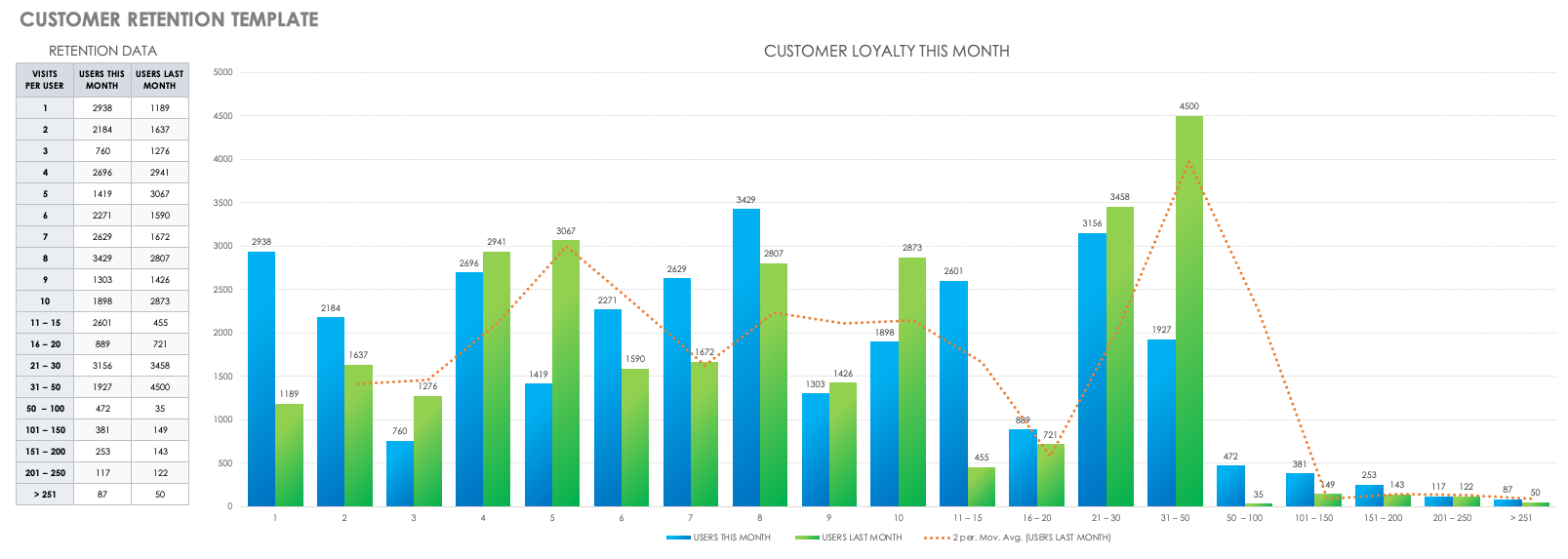What Is Customer Retention?
Customer retention is the work that organizations do to maintain current customers and keep them as repeat customers. This work begins when an organization acquires a new customer, as it tries to ensure the customer is happy with the organization’s products or services.
For example, a company might create a formalized onboarding program to retain customers. This is the process of introducing new clients to your company. It may include ensuring that your new customers know how to fully use your product or service, if applicable, and easily reach someone in your organization if they have any questions.
For professional service organizations, onboarding is exceptionally important because it establishes your organization’s credibility and helps you build trust with the client.
You can learn more about client onboarding at “The Definitive Guide to Client Onboarding.” You can learn more about best practices and expert advice on how to set up a system to effectively manage clients and maintain good relationships from out article "Tips and Best Practices for Mastering Client Management".
Benefits of Customer Retention
The key benefit of customer retention is simple: it is the best way for your organization to succeed. Here’s why:
- Customer retention is the most effective way to grow revenue. It is much less expensive to keep a current customer than it is to try to acquire a new customer. Bain & Company has estimated it costs six to seven times more to land a new customer than it does to keep a current customer.
- It provides a huge return on investment. Not only are your current customers much less expensive to keep, but they also offer much greater lifetime value (how much they could spend with your organization over their lifetime). Customers who’ve been with your organization for a while are much more likely to continue to be customers — and bring your organization built-in and ongoing revenue — for years down the road.
- It leads to more referrals. When you work to retain your current customers, you not only continue to make them happy, but also increase the chance they will become brand ambassadors by telling others about your good work.
Benefits and Costs of Customer Retention vs. Customer Acquisition
Business research has provided interesting insights into the costs and benefits of retaining a current customer compared to trying to acquire a new one, including the following:
- Increasing customer retention by 5 percent can lead to an increase in profits of 25 to 95 percent, depending on the industry, according to Bain & Company research.
- The probability of converting an existing customer into a repeat customer is 60 to 70 percent, while the probability of selling to a prospective customer is 5 to 20 percent, according to Marketing Metrics.
- A 2 percent increase in customer retention is equivalent to decreasing your organization’s costs by 10 percent, according to Leading on the Edge of Chaos, by Emmett Murphy and Mark Murphy.
“If you look at revenue growth, it’s pretty easy to see,” says Justin Butlion, a business analytics consultant and founder of Projectbi.net, which provides information and advice on using business analytics and data. “If you’re looking at the right graph and your retention rates are poor, it’s going to be almost impossible to grow your business.”
“The cheapest client is the one you already have,” says Michael J. Levin, a motivational speaker and president of Custom Solutions, Inc., a California business consultancy. “Acquisition costs are extremely expensive."
“Managing your current customer is going to be the key to growing your business,” says Levin.
What Is a Customer Retention Strategy?
A customer retention strategy is the approach your organization employs to ensure your customers are happy. A particular department may focus on customer retention work, but everyone in your organization must understand and follow the strategy.
Top Customer Retention Strategies
Experts recommend a range of effective customer retention strategies and practices. The most successful approaches focus on doing exemplary work for clients and proactively working to communicate well with them while building good and trusting relationships.
Below are some strategies and practices to improve customer retention:
- Make a good first impression. It’s very important to start off well with a new customer. If the customer doesn’t have a great experience with that first purchase, in terms of liking your product and appreciating how your organization helps them with issues or questions, they’re unlikely to come back. Make sure you treat them well from the beginning.
- Set a retention goal. You need to set a specific goal to improve your retention rate. Calculate your current customer retention rate. Then set a realistic goal to improve that rate. Below, you can download a template to help you track customer retention.
Download Customer Retention Template — Excel
- Become a trusted advisor. You’re the expert in your field. Show and provide that expertise to your customers, so you can gain their trust and build loyalty. That might mean developing a semi-formal customer education program or simply sharing with your customers content that is helpful and relevant to their industry.
- Provide good customer service. Customers — both new and current clients — quickly bolt when customer service is poor. Your organization must provide a good product or service. It’s just as important to provide good customer service as it is to provide a strong product or service.
- Create gamification and referral programs. Many organizations use referral programs to retain customers and gain new ones. MeUndies, an underwear manufacturer, asks current customers to refer the company’s products to a friend. For every friend who makes a subsequent MeUndies purchase, the current customer gets $20 and the new customers get 20 percent off their first purchase.
- Send a company newsletter. A regular newsletter from your organization, including information about your work, your industry, and your clients’ industries, can remind customers of your good work and expertise.
- Don’t always be selling. Be collaborative, and be a good resource for your clients. This means you’ll want to have many interactions with customers and clients just to be helpful, even when it doesn’t relate to a direct sale for your organization.
“I believe in collaboration as opposed to selling,” says Levin, from Custom Solutions, Inc. “I want to create an open and honest conversation with a client to where they will tell me things. The only time, personally, that I sell is when I get permission from a client to sell."
Levin says providers need to say to clients: “Let’s have an open, honest conversation and collaboration, so we can figure out how we best work together. When you get to that state with the customer, it’s so much easier to do business.
“Seek to have collaborations and conversations, as opposed to negotiations and presentations,” he adds.
Dylan Max, head of growth marketing at Netomi, a customer service company focused on support automation with chatbots and conversational artificial intelligence, agrees. “At the end of the day — no matter what your business is — you are dealing with people. And it’s important ... to not necessarily always be selling,” he says. - For online sellers, create fewer issues for checkout. The easier your organization’s website makes it to buy a product — and buy again after the first time — the better. Amazon’s checkout process is a good example of making it easy for customers to buy online, as it keeps address, payment, and other information available to easily reuse.
- Use social media to build relationships. Potential customers are influenced by what their friends and colleagues say on social media platforms about your organization. Find ways to encourage satisfied customers to share their experiences on social media, and amplify them through your own channels.
- Go above and beyond. When your organization gives special attention to customers and takes extra steps to provide good service and ensure they’re happy, you can create lifelong customers.
That factor helped Netomi’s Max decide on which accountant to use. “I used to live in Iowa. I got great customer service from a tax accountant. Even though I live in California now, I keep that relationship with that person — because they have been excellent for me,” he says.
Butlion, the business analytics consultant, says online shoe and clothing retailer Zappos is an example of a company that provides fairly traditional products but extraordinary customer service and is rewarded for it.
Zappos is famous for its customer service. In 2011, the company sent flowers to a woman who had ordered several pairs of shoes because harsh medical treatments had damaged her feet. It sent a free pair of shoes to a man who showed up as best man at a wedding without shoes. In 2015, Zappos delivered a gift to every household — about 1,900 — in Hanover, New Hampshire. The town had a high number of especially loyal Zappos customers.
The results of such service: One survey found that 44 percent of new Zappos customers heard about the company only by word of mouth. And 75 percent of Zappos purchases come from repeat customers. The company reached $1 billion in sales within its first 10 years. Its annual revenues now exceed $2 billion.
“They’ve become known as the case study of how important customer relations can be for a company,” Butlion says. - Personalize the experience. When you can, reach out and treat customers as individuals, not just as clients.
Butlion cites the story of entrepreneur Gary Vaynerchuk, who owns communications company VaynerMedia and a number of other enterprises, including an online wine sales company. Vaynerchuk, a huge New York Jets fan, saw that a customer was also a Jets fan. “He bought him a (Jets) jersey and sent it to him. He was one on one, treating people like humans,” Butlion says.
Butlion says that sort of behavior is not difficult, even when your company has many customers.
“If you’re an account manager with 100 customers or 200 customers ... dedicate 10, 20, or 30 minutes a month toward each — to look at them as humans. Take that information and put it into the [customer relationship management software] and act on it,” he says.
“You’ve got to instill that culture within the company. Where can we be proactive (with clients)? So much is reactive. How can we make it more proactive? That’s huge. It’s a huge way to improve and differentiate your service.” - Use a communications calendar. Even when your customers don’t reach out to you, reach out to them. Establish a communications calendar and follow it, so you’re proactively reaching out to customers regularly. You might simply remind them of your products or services or offer incentives to purchase again. To learn more about effectively tracking your communications with customers, visit our Customer Communication Management article.
- Reduce passive churn. Your organization can lose some customers simply because your digital system inadvertently kicks them out. Subscription-based services, for example, might delete a customer because of an expired credit card. Establish procedures and software that prevents those inadvertent problems from happening.
- Create loyalty programs and reward especially valuable customers. Make sure you reward return customers with discounts, gifts, and other benefits. And make sure you give special attention and rewards to especially valuable customers.
- Provide a valuable upsell. After new customers have tried your product or service, they are often open to other products. Offer them a new product or expanded services during this window of opportunity.
- Attend to the basics of customer relationships. The average business loses about one-fifth of its customers through neglect — it doesn’t do even the basics to establish a relationship with them. In some industries, up to four-fifths of customers are lost due to inattentiveness. To learn more about customer relationship management, check out the customer relationship management article that’s part of this series.
What Is a Customer Retention Rate?
A customer retention rate is the rate at which your organization keeps its current customers as repeat customers. Organizations track this rate and use it as a barometer of future revenues and overall success.
How Retention Rates Differ by Industry
Retention rates differ by industry, of course. According to an analysis of service firms by the research organization Statista, the average professional services firm was able to retain 84 percent of its customers in 2018; the average insurance firm retained 83 percent of its customers. Statista also found that the average financial services firm kept 78 percent of its customers and the average consumer services organization retained 67 percent.
In contrast, users of online services and mobile apps were much less loyal. According to a 2017 study by internet analytics firm Mixpanel, average retention rates were about 20 percent after eight weeks for software-as-a-service firms; 15 percent for media websites and apps; 13 percent for finance websites and apps; and 6 percent for e-commerce websites.
Customer Retention Metrics
The most common metric that organizations use is the customer retention rate (the percentage of customers that remain repeat customers after a specified time period). They also use the churn rate or attrition rate, the repeat customer rate, and the average order value.
Customer Retention Rate Formula
The formula to determine your organization’s customer retention rate is the existing customers at the end of a period minus new customers acquired during the period divided by customers at beginning of period times 100.
If you have 120 customers at the end of a specified period, acquire 40 new customers during the period, and have 100 customers at the beginning of the period, your organization’s retention rate would be 80 percent (120-40/100 x 100=80).
Other Metrics that Measure Customer Interactions
You can track a number of other metrics to provide insight into your customers’ satisfaction and purchasing, including the following:
- Churn Rate: Sometimes called the attrition rate, this is the percentage of customers who stop doing business with an organization in a specified period (the converse of the retention rate). Here’s the formula to get your churn rate:
If you lose 20 customers during the period and have 100 customers at the beginning of the period, your churn rate is 20 percent (20/100 x 100=20). - Repeat Customer Rate: This refers to the number of customers who are willing to make a second purchase from your organization. This rate might be similar to, but is not always exactly the same as, your retention rate. Here’s the formula to get repeat customer rate:
If you have 30 customers who purchased more than once during a period and 100 unique customers during that period, your repeat customer rate is 30 (30/100 x 100=30). - Purchase Frequency: This refers to your organization’s total sales compared to the total number of customers. The formula is as follows:
If you have 130 sales during a period and 100 unique customers, your purchase frequency is 1.3 (130/100=1.3). - Average Order Value: The average value of each sale. The formula is as follows:
Total sales revenue/number of sales
If you sell $1 million worth of products or services during a period and have 100 sales or orders during that period, your average order value is $10,000 (1,000,000/100=10,000). - Net Promoter Score: This metric isn’t derived from the number of sales or customers, but rather from a simple customer survey. The survey should ask three to five questions about how a customer views your organization, one of which should be: “On a scale of 1 to 10, how likely is it that you would recommend [the organization] to a friend, family member, or business associate?”
Customers who give an organization a score of 6 or below on that question are considered “detractors”; those who award a 7 or 8 are considered “passives”; 9 or 10 are “promoters.”
The Net Promoter Score is determined by subtracting the percentage of detractors from promoters. If 30 percent of responders are promoters, 50 percent are passives, and 20 percent are detractors, your Net Promoter Score is 10.
Experts differ on their views of a “good” Net Promoter Score. The scores also vary significantly by industry — which means your organization must consider the industry average in analyzing your score.
In general, however, a score above zero is acceptable. A score above 30 is very good. A score above 60 is exceptional.
Butlion said organizations should set up a system to regularly ask customers about their views and determine their Net Promoter Score.
“The primary goal of account management is to proactively gauge the satisfaction the customer has with the service,” he says.
Netomi leaders have also written about other ways to gauge customer service performance through customer satisfaction (or CSAT) scores and other customer service key performance indicators.
Using Data Analysis to Help Understand and Improve Customer Retention
Any organization can better understand its customers — and improve the chance they will remain customers — by looking at and reacting to some underlying data.
Here are some ways to use customer data to improve retention:
- Look for possible churn in advance. Is a customer not communicating with you after a first purchase? How long has it been since the customer made that initial purchase? Or did the customer make regular purchases for a while and hasn’t made any for a year? Analyze the data and use what you learn to proactively reach out to customers and offer them incentives or simply keep them engaged.
- Perform A/B tests. You might consider an email to inactive or former customers, with specific language pitching your product or service. But maybe an email with an entirely different pitch would work better, or maybe an incentive or discount would help. You can determine what is most effective by sending one “A” option to half of this group of customers, and a “B” option to the other half. The results can steer you toward the best way to renew interest from customers.
What Is Customer Retention Management?
Customer retention management is the structure and processes your organization puts in place to effectively coordinate customer retention.
That structure might include organizational employees or teams that, for example, work with your staff to demonstrate effective ways to relate to customers and former customers. Organizations can also use customer retention management to help develop and monitor customer service and customer retention metrics that measure success.
Strategies for Customer Retention Management
Experts recommend a range of practices to effectively manage customer retention, including the following:
-
Highlight how you work with clients. During the sales process, highlight past examples of how your organization works with clients. By giving details on how you communicate and collaborate, you help prospective clients determine whether your work style matches what they want.
-
Set expectations. It’s important that your organization and clients have similar expectations in how the collaboration will work and what is the desired outcome for the project.
-
Continually share project progress and results. Every project has interim successes and metrics that show those successes (or hint at problems). It’s important you regularly share those metrics and results with your clients.
-
Develop a roadmap for the relationship’s future. Organizations shouldn’t be satisfied with a client relationship that is just going OK. It’s important to think in broad terms about where the relationship between your organization and the client could and should advance to in the future. Be specific about steps and initiatives that both sides could work on to move into the future together.
-
Perform customer lifecycle management. This means looking at touchpoints in a project or in a client’s relationship with your organization. Make sure you understand — with data, whenever possible — how your customer feels about your organization. Make adjustments when necessary.
-
Engender strong employee loyalty. Organizations that create an environment that encourages strong employee loyalty also bring more customer loyalty. That’s because employees who are treated with respect and given tools they need to succeed then work harder to keep customers happy. One study by the Jackson Organization found that companies that “effectively appreciate employee value” did significantly better financially than companies that didn’t. Their return on assets and equity was more than three times larger.
-
Create memories around success. People are more likely to remember negative events, so you need to help people remember when things go right. Celebrate large — and sometimes small — accomplishments on your projects.
-
Map the customer journey. You can’t fully understand a customer’s experience with your organization until you analyze from their perspective how they experience your organization.
In customer journey mapping, your team examines the route a customer takes with your organization from when they’re only a prospective customer to when you’ve finished their project or completed a sale to them and beyond. This investigation shows issues that can occur, for example, as the customer’s interests are transferred from one department to another in your organization.
Brian Zotti, Senior Vice President of Services and Operations at Contek Consulting LLC, a business strategy consultancy, says a big problem in many organizations is a siloed departmental structure, where departments pass customers and clients off with little collaboration.
“The various compartmentalized ways an organization is structured and the metrics used to define success are not thought out from a holistic point of view,” he says.
Zotti says he often works with departments within companies to help them see these problems, and then meets with company executives to relay the information. For instance, “‘Here’s how each department fits in the journey — all of the different ways the customer is exposed to us. Here’s a point where we generate complaints. Here’s how we define success in each of the departments — but there’s an overall loss of revenue and losses of customers.’”
Customer journey mapping can also help you understand how a prospective customer becomes a customer. How did they learn about your organization? Have they followed you on social media? Answering some of these questions helps you understand how to attract and retain more customers.
-
Encourage departmental collaboration to improve customer service. Organizations must get their departments together and work on ways to implement processes and incentives that improve — rather than hinder — customer service.
Organizations “have a responsibility to understand all of the various steps it takes to acquire a customer, how the customer is moved through the organizational system, and what happens to that customer. How do they access help? What are the various channels they use to buy?” asks Zotti.
“Once everyone sees that experience — and that picture is going to look chaotic — it usually provides an eye-opening view of how much loss happens, how much effort the customer needs to apply, [and] the degree to which internal teams are making decisions that have adverse effects on customer retention.” -
Create a customer relationship marketing strategy. Customer relationship marketing is different from your organization’s overall marketing strategy: It is about focusing efforts on individualized ways you can reach out to current and former customers to offer help and remind them of your organization’s value. To learn more about customer relationship marketing, visit Customer Relationship Management article.
-
Create a customer advisory board. Your loyal customers are valuable for reasons apart from the revenue they bring. They can also tell you what they especially like about your organization and when you go astray and need to adjust. Some of them might be honored to form part of an “advisory board” that can help guide your organization’s ongoing work with customers and former customers.
-
Examine your brand value proposition. Customers often want more than an organization that can help them with a specific need: They also want to do business with organizations that have similar values and support the same larger goals. That might include sustainable practices or other ideals. Make sure your customers understand the larger values your organization represents.
-
Document past communications, preferences, and issues. Your organization must have a system — software or otherwise — that documents all important information about a client. This should include the customer’s preferences, past communications and project issues, details on personnel, and a range of other information.
-
Ensure the customer has a relationship with the team. Customers may have a close relationship with specific members of your team (leaders on the customer’s project, for instance). But an organization must ensure that a wide range of your staff develops a relationship with the customer. Your organization’s staffing may change, and you don’t want the relationship to sour simply because one or two people have left their positions.
-
Engender brand loyalty. Brand loyalty often comes not from your programs or tactics, but from a customer’s appreciation for your organization’s overall values. Brand loyalty is exceptionally valuable, in terms of your customers remaining as customers and of them acting as advocates for your organization.
-
Do favors that increase customer loyalty. Do nice things for your customers that go beyond their expectations. That might mean offering their employees tickets to a concert or a professional basketball game. Or it might mean providing extra services that aren’t difficult for your organization to do but wouldn’t be expected by the customer. Customers remember those acts and often reciprocate with greater loyalty to your organization.
-
Give customers the tools they need to succeed. Rather than having customers wait on your customer support staff to help them with certain simple tasks, give them the tools to accomplish those tasks themselves. This way, your staff can continue to do the work it does best, and your customers will appreciate being able to accomplish simple tasks without having to wait.
-
Ask for feedback and act on it. You will never be able to retain more customers until you understand why some customers are dissatisfied enough to leave your organization. Gather feedback and make adjustments where necessary. To learn more about gathering feedback from customers, visit Customer Communication Management article.
Improve Customer Retention with Real-Time Work Management in Smartsheet
Empower your people to go above and beyond with a flexible platform designed to match the needs of your team — and adapt as those needs change.
The Smartsheet platform makes it easy to plan, capture, manage, and report on work from anywhere, helping your team be more effective and get more done. Report on key metrics and get real-time visibility into work as it happens with roll-up reports, dashboards, and automated workflows built to keep your team connected and informed.
When teams have clarity into the work getting done, there’s no telling how much more they can accomplish in the same amount of time. Try Smartsheet for free, today.




